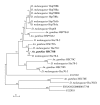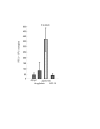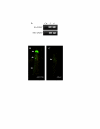Anopheles gambiae heat shock protein cognate 70B impedes o'nyong-nyong virus replication
- PMID: 17625007
- PMCID: PMC1963456
- DOI: 10.1186/1471-2164-8-231
Anopheles gambiae heat shock protein cognate 70B impedes o'nyong-nyong virus replication
Abstract
Background: Phylogenetic and functional analysis was conducted on an Anopheles gambiae gene, ENSANGG00000017398. Based on phylogenetic analysis, this gene belongs to the same lineage as Heat shock protein cognate 70-4 (Hsc70-4) in Drosophila. Accordingly, we propose to name this gene Heat shock protein cognate 70B (HSC70B). We previously reported that expression of HSC70B and other genes including elongation factor-1alpha (EF-1alpha) and the agglutinin attachment subunit (agglutinin) were up-regulated in o'nyong-nyong virus (ONNV)-infected female An. gambiae. Double-stranded RNA interferences have been applied to further investigate HSC70B, EF-1alpha and the agglutinin functions in ONNV replication in An. gambiae.
Results: Among these three RNAi silenced genes, only dsRNAs of HSC70B (dsHSC70B) promoted ONNV replication in adult An. gambiae compared to the control mosquitoes that were co-injected with ONNV and dsRNA of beta-galactosidase (dsbeta-gal). ONNV titers from mosquitoes co-injected with dsHSC70B were about 9-fold higher at 6 days post-injection (d.p.i.) as compared to the control mosquitoes. By using ONNV tagged with enhanced green fluorescent protein (ONNV-eGFP), co-injection of ONNV-eGFP with dsHSC70B also showed approximately 2 ~ 3-fold higher GFP expression rates than the controls in the head, thorax, and abdomen of the mosquito. Furthermore, co-injection of ONNV with dsHSC70B significantly reduced the lifespan of adult mosquitoes as compared with the control, co-injection of ONNV with dsbeta-gal treated mosquitoes.
Conclusion: These results indicate that HSC70B plays important roles in homeostasis and suppression of ONNV replication in the vector, An. gambiae. Biological implications of these findings are that while mosquitoes allow ONNV to replicate in them, they also check viral titers so that ONNV infection will result in no harmful effect on mosquitoes. Therefore, mosquitoes can function as vectors of ONNV transmission to humans while ONNV infection in An. gambiae remains asymptomatic.
Figures






References
-
- Karabatsos N. Antigenic relationships of group A arboviruses by plaque reduction neutralization testing. Am J Trop Med Hyg. 1975;24:527–532. - PubMed
-
- Johnson BK. O'nyong-nyong virus disease in The Arboviruses. In: Monath TP, editor. Epidemiology and Ecology. Vol. 3. Boca Raton, FL , CRC Press; 1988. pp. pp 217–223.
Publication types
MeSH terms
Substances
Grants and funding
LinkOut - more resources
Full Text Sources
Miscellaneous

